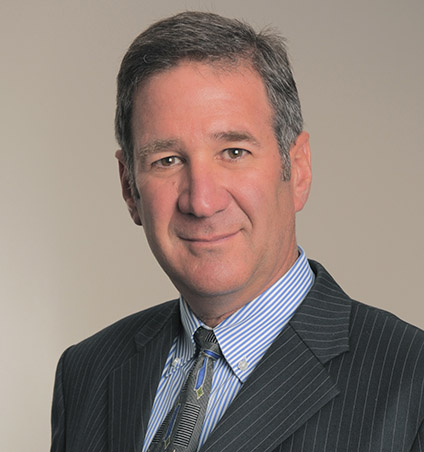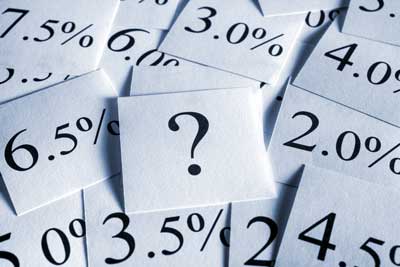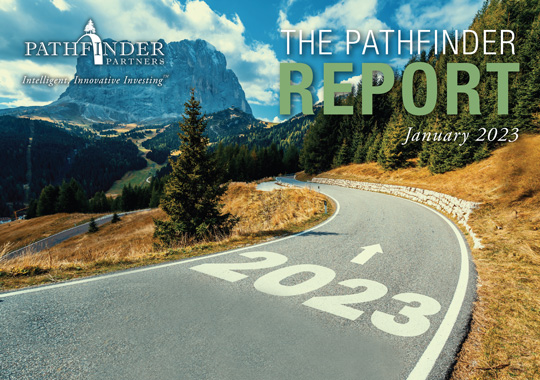Charting the Course
Is This an Economic Pivot Point?
By Mitch Siegler, Senior Managing Director

There are a couple of things we know for certain and a long list of things we don’t know the slightest thing about. 2022, now in the rearview mirror, brought that home in spades. As we begin the new year, several important economic trends seem to be coming into focus and a time of lower volatility and greater clarity may be approaching.
We see four potential, emerging trends: the worst supply chain disruptions may be behind us; economic growth is slowing; inflation seems to be cooling; and the pace of interest rate rises may be moderating. If these trends hold, there are profound implications for businesses and investors. Below is our parsing of the tea leaves on these four conditions.
Dare We Hope that the Worst Supply Chain Disruptions Are Behind Us? – The past year was a perfect storm for supply chain disruptions. Russia’s war against Ukraine, launched last February, significantly disrupted markets for energy, food, fertilizers, raw materials, ocean shipping and more. While the end of the war remains out of sight, Russian advances have slowed, and Ukrainian resistance has remained strong. Geopolitical optimists might even hope that this conflict may be closer to its end than its beginning.
While nobody knows when and how this war will end, NATO countries seem united in providing military and financial support for Ukraine and Europe continues to make progress in becoming less dependent on Russian energy. American consumers are finally benefiting from lower gasoline prices, which have fallen by one-third, from a peak of $5.11 in mid-June to $3.37 in mid-January; average U.S. gas prices are now back to their pre-war levels. As energy costs are a primary input for so many manufactured goods and the key cost input for the trucking sector, lower gas prices will surely ripple through the supply chain in a major and positive way, contributing to cooling inflation and lessening the need for substantial Fed interest rate hikes later in 2023.
 Exhibit “B”, China’s role as the world’s factory, was a significant contributor to supply chain challenges last year and now, as China’s zero-Covid policy is unwound, should be a major catalyst for lessening supply chain pressures. In turn, rising prices for manufactured goods last year should give way to more stable, even falling prices for electronics, furniture, apparel and other Chinese-made goods in 2023.
Exhibit “B”, China’s role as the world’s factory, was a significant contributor to supply chain challenges last year and now, as China’s zero-Covid policy is unwound, should be a major catalyst for lessening supply chain pressures. In turn, rising prices for manufactured goods last year should give way to more stable, even falling prices for electronics, furniture, apparel and other Chinese-made goods in 2023.
Furthermore, China’s stringent “zero-Covid” policy – which led to closures of large factories and ports and even virtual shutdowns of major cities, crumbled in December. As Chinese officials essentially “let the chips fall where they may,” the country’s factories are beginning to gear back up. But much damage was done to China’s economic engine and economic growth in China slowed dramatically last year (from 8.1% in 2021 to an estimated 2.7% in 2022, per the World Bank). The World Bank forecasts a recovery in China’s growth to 4.3% in 2023 – still a roughly 50% decline from 2021 levels. We can only hope this month’s lunar New Year, when hundreds of millions of Chinese travel from urban to rural areas, won’t lead to reports of massive illness and death and a further setback for China’s economy and global supply chains.
Overall Economic Growth is Slowing – Economic growth in China, the world’s third-largest economy, has major implications for global growth. The World Bank slashed its growth forecast for the global economy in 2023 in part because of China’s slowdown as well as elevated risks of a global recession. The bank expects global growth to slow from 3% in mid-2022 to 1.7% in 2023. This tepid level of growth, certainly nothing to write home about, would be enough to keep the world economy out of recession territory.
In the “what we don’t know” department, many questions remain about how the economy will look this time next year. Will we be in a recession? Will we have a soft landing? The answers to those questions will likely be bound up in what the Federal Reserve (Fed) does this year, which will be driven in large part by inflation news.
Inflation Appears to Be Cooling –The mid-January announcement that inflation continued to slow on an annual basis in December provided welcome relief for Americans who’ve struggled to keep up with rising prices for groceries, gasoline, autos and more. It also provides a bit of cover for policymakers at the Federal Reserve (Fed) and for the Biden Administration.
The December Consumer Price Index (CPI) rose 6.5%, down from 7.1% in November and nearly one-third below the peak rate of 9.5% reached in June – the highest inflation reading in 40 years. December’s “core” rate of inflation (which removes the impact of food and energy prices) ran 5.7%. While these rates of inflation are decidedly unsustainable, they’re a darn sight better than what Americans experienced earlier in 2022.
The rate of inflation is moderating meaningfully though considerable uncertainty remains about the timing for it to return to a more normal 2%. As policymakers at the Fed monitor the economic tea leaves – watching employment data, equity markets, the 2-year/10-year yield spread, money supply growth and more – it is our hope that they’ll make wise decisions to balance keeping a lid on inflation while allowing the economy to chug along.
 The Pace of Interest Rate Rises may be Moderating – The Fed is not finished raising interest rates and most analysts expect rates to remain at or above current levels for an extended time – likely much of this year. We’re encouraged that the rate of change in interest rates has been slowing and many analysts expect the pace of change to continue to moderate, with the peak of the Fed rate hike cycle possibly occurring this March.
The Pace of Interest Rate Rises may be Moderating – The Fed is not finished raising interest rates and most analysts expect rates to remain at or above current levels for an extended time – likely much of this year. We’re encouraged that the rate of change in interest rates has been slowing and many analysts expect the pace of change to continue to moderate, with the peak of the Fed rate hike cycle possibly occurring this March.
“I expect that we will raise rates a few more times this year, though…the days of us raising them 75 basis points at a time have surely passed,” said Patrick Harker, president of the Federal Reserve Bank of Philadelphia on January 5. The Fed Funds rate – now 4.50%-4.75% – will likely rise 25-50 basis points in February with another (dare we hope final?) increase at the Fed’s March meeting. That would put the Fed Funds rate later this quarter in the 5.00%-5.50% range. (A basis point is 1/100 of a percent.)
Since investors are scared silly about inflation, they should be cheered by cooling producer and consumer prices. And as markets hate uncertainty, a flattening of the rate hike curve should provide welcome relief to investors in the year ahead. While we’re not expecting boom times in 2023, lessened anxiety and lower volatility are always welcome. Here’s to a better year ahead.
Mitch Siegler is Senior Managing Director of Pathfinder Partners. Prior to co-founding Pathfinder in 2006, Mitch founded and served as CEO of several companies and was a partner with an investment banking and venture capital firm. He can be reached at msiegler@pathfinderfunds.com.
Share this Article
IN THIS ISSUE
PATHFINDER PARTNERS INCOME FUND, L.P.
A Stablized Multifamily Fund
CHARTING THE COURSE
Is This an Economic Pivot Point?
FINDING YOUR PATH
What Goes Up, Must Come Down (To Earth)
GUEST FEATURE
An Article about Nothing
GUEST FEATURE
Resiliency: An Important Driver of Value for Businesses and Investors
ZEITGEIST
News Highlights
TRAILBLAZING
Hiawatha, Seattle, WA
NOTABLES AND QUOTABLES
Integrity
